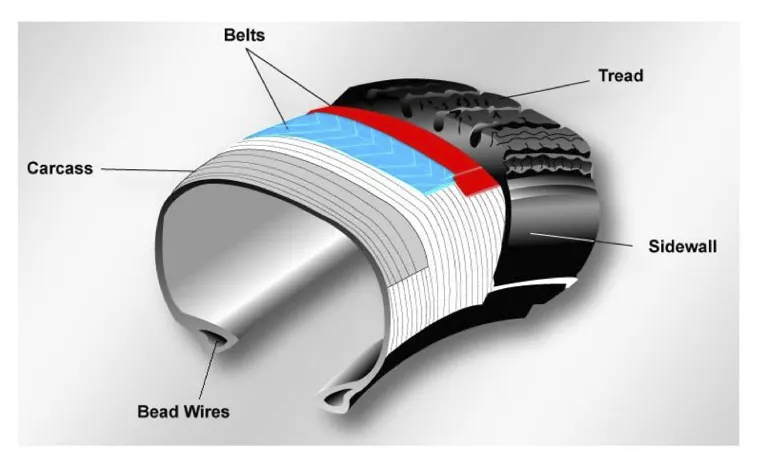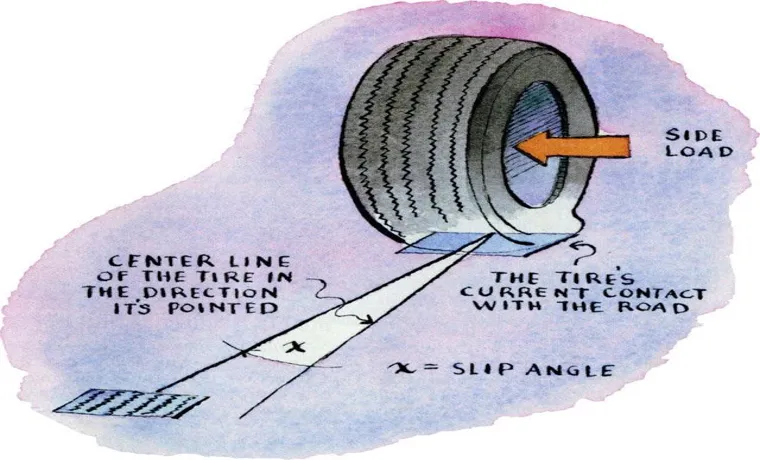Have you ever wondered how car tires work? We all know that tires support the weight of our vehicles and help us travel smoothly on the road. But, they do much more than that. In fact, tires play a crucial role in ensuring our safety on the road.
Have you ever wondered how they do that? How do tires grip the road in order to provide traction? What makes them durable enough to withstand various road conditions? In this blog post, we will explore the inner workings of car tires and discover what makes them so important for our driving experience. From their various components to the science behind their design, we will take a deep dive into the world of car tires. So, buckle up and let’s dive into the fascinating world of how car tires work.
Table of Contents
Overview
Have you ever stopped to wonder how does a car tire work? Well, a car tire is more than just a rubber exterior that holds air. It’s actually a complex piece of engineering that ensures your safety while driving. Firstly, the tread of the tire provides traction between the tire and the road, which is vital for steering and braking.
Then, the sidewalls of the tire offer support for the vehicle and absorb any impacts or shocks from the road. In addition, the tire’s internal structure, including the cords and belts, make it flexible yet strong enough to handle the weight of the vehicle. Finally, the tire is sealed to ensure optimal air pressure.
The tire’s design and composition help to maximize fuel efficiency, longevity, and safety, making it an essential piece of equipment for any vehicle.
What are car tires?
Car tires are an essential component of any vehicle. They are the round, rubber pieces that connect a car to the road and help it to move forward. Tires come in a variety of shapes and sizes, each designed for a specific purpose.
They are made up of different layers, including the tread, sidewall, plies, belts, and beads. The tread is the part of the tire that comes into contact with the road, providing grip and traction. The sidewall acts as a protective barrier for the tire, helping to prevent damage and punctures.
The plies are layers of rubber and fabric that provide strength and stability to the tire, while the belts are steel wires that add rigidity. The beads hold the tire onto the wheel rim. Car tires are designed to withstand a significant amount of wear and tear and can last for anywhere between 25,000 to 75,000 miles, depending on the type of tire and how they are used.
It’s important to choose the right tires for your vehicle and driving conditions to ensure optimal performance and safety on the road.

What are the main components of a tire?
Tires may seem like simple rubber circles, but they are actually a complex combination of several different components. These include the tread, which is the pattern on the outer surface of the tire that provides traction; the carcass, which is the body of the tire made up of layers of rubber-coated fabric cords; and the sidewall, which provides protection for the carcass and also displays important information such as the tire’s size and load capacity. Other important components include the inner liner, which helps to maintain tire pressure and prevent air from escaping, and the bead, which anchors the tire to the wheel.
All of these components work together to create a safe, durable tire that can withstand the rigors of the road. So, the next time you’re driving down the highway, take a moment to appreciate the engineering marvel that is the tire!
How Tires Generate Friction
Car tires work by generating friction between the tire and the road surface to provide grip and allow the car to move. Tires are made up of multiple layers, including the rubber tread that comes into contact with the road. When the car is in motion, the tire’s tread molds over any irregularities in the road surface, providing a larger contact patch.
The friction the tire generates comes from the forces of adhesion and deformation. Adhesion is the force that holds two materials together when they come into contact, and in this case, it is the force that acts between the tire and the road surface. Deformation occurs when the tire flattens slightly against the road surface, creating a deformation force that provides additional grip.
As the tire rotates, these forces combine to provide the friction needed for the car to move forward, turn, and stop. Additionally, the tread patterns on the tire also play a role in generating friction, with different patterns designed for various road conditions. Overall, a car tire’s ability to generate friction is what makes it a crucial component in ensuring a safe and smooth driving experience.
The Role of Traction
Traction is essential for any vehicle to move forward or stop. The role of tires is to generate the necessary friction required for traction. Friction is a force that opposes the motion of the vehicle.
Tires create friction due to the contact of their surface with the road surface. The tread patterns on tires help to increase the friction by increasing the surface area that comes in contact with the road. The rubber compound used in tires also plays a crucial role in generating friction.
Soft rubber compounds generate more friction than hard compounds as the former can conform to irregularities on the road better. Additionally, the air pressure inside the tire affects traction. Overinflated or underinflated tires may reduce the friction between the tire and the road, causing the vehicle to skid or slip.
The role of traction is thus critical for safe driving, and ensuring that tires are in optimum condition is vital to ensure reliable traction for a vehicle.
The Function of Tread Patterns
Tread patterns play a crucial role in how tires generate friction. The design of the tread allows for the tire to grip the road, creating the necessary traction needed for safe driving. The pattern of the tire’s tread is what determines how well it performs in different weather conditions and on different surfaces.
For instance, tires designed for winter weather have a tread pattern that helps it to cut through snow and ice, while those designed for wet roads have a pattern that aids in dispersing water to prevent hydroplaning. The pattern also controls how much noise a tire produces and how fast it wears out. Different types of tires have unique tread patterns that suit their specific purpose, such as off-road tires’ aggressive tread pattern designed to provide traction on rugged terrain.
Ultimately, the tread pattern functions as the tire’s contact point with the road, ensuring that drivers can trust their vehicle’s handling in any environment.
Factors that Affect Traction
Tires generate friction through several factors. The first is the material of the tire itself. The tread, sidewall, and carcass all play a crucial role in creating the necessary friction between the tire and the road surface.
Tire tread design is also essential, with different patterns and grooves providing varying amounts of traction on different surfaces. The temperature of the tire also affects traction, with colder temperatures reducing the tire’s grip on the road. The pressure of the tire is also crucial, with underinflated tires reducing the amount of contact between the tire and the road surface, ultimately reducing traction.
Finally, the tire’s speed and the surface it travels on are other factors that affect traction. For instance, a tire traveling at high speeds is likely to generate more heat, resulting in reduced friction. On the other hand, a smooth surface offers less friction than a rough one, affecting the tire’s ability to grip the road.
Understanding these factors can help drivers make better decisions when selecting tires, ensuring optimal performance and safety on the road.
The Importance of Inflation Pressure
If you’ve ever wondered how a car tire works, it’s important to understand the role of inflation pressure. Properly inflated tires allow for optimal handling, steering, and braking performance, while also contributing to fuel economy and preventing premature wear and tear. Inflation pressure is measured in psi (pounds per square inch), and the recommended psi varies depending on the make and model of the vehicle, as well as the type of tire.
Underinflated tires can lead to decreased fuel efficiency, increased stopping distances, and potential blowouts, while overinflated tires can result in poor handling and a rough ride. Checking tire pressure regularly and maintaining the recommended psi can help ensure safe and efficient driving. So next time you hit the road, take a moment to consider the importance of inflation pressure in keeping your vehicle running smoothly.
How Tire Pressure Affects Performance
Have you ever considered the importance of maintaining proper tire inflation pressure on your vehicle? Well, let me tell you, it can greatly affect your car’s performance. In fact, it’s one of the most critical factors. When tires are underinflated or overinflated, it leads to inefficient running, which can cause a decrease in performance, fuel efficiency, and safety.
Low tire pressure reduces road grip, making it harder to turn corners and brake. On the other hand, high pressure can lead to stiffness, which reduces the contact area of the tire with the road and can cause a bumpy ride. Therefore, it is essential to check and maintain tire inflation pressure regularly to ensure your vehicle’s performance and safety.
By doing this, you get to experience excellent steering response, better fuel economy, and a smooth, comfortable ride. Don’t let an underinflated or overinflated tire hinder your driving experience and also affect your safety; make sure you properly maintain your tire inflation pressure.
Recommended Inflation Pressures
Proper tire inflation is crucial to your vehicle’s overall performance, longevity, and safety. It affects fuel economy, handling, and the lifespan of your tires. Ensuring that you maintain the recommended inflation pressure is not only easy but essential.
Overinflated or underinflated tires can cause uneven wear and tear, reduced handling, poor fuel economy, and an increased risk of blowouts and accidents. To determine the proper inflation pressure, check the vehicle owner’s manual or the tire information placard located on the driver’s side door jamb. The recommended pressure is based on the vehicle’s weight and tire size and is usually given in pounds per square inch (PSI).
Check your tire pressure regularly, ideally once a month, and always before long trips or heavy loads. It’s a simple yet crucial aspect of vehicle safety and maintenance that should not be overlooked. Keep your tires inflated to the recommended pressure, and you’ll enjoy a better ride, improved handling, and a longer tire lifespan.
Conclusion
In short, a car tire is like a superhero for your car – it’s responsible for keeping you grounded and safe, whether you’re cruising on the highway or taking on a treacherous mountain road. Through a combination of scientific principles like friction, air pressure, and elasticity, tires are able to provide the perfect balance of traction, comfort, and durability. So, the next time you hit the gas pedal and feel the power of your car beneath you, remember that it’s all thanks to the humble tire – the unsung hero of every road trip.
And always remember to check your tire pressure and tread depth regularly, because even superheroes need a little maintenance now and then!”
FAQs
What is the function of a car tire?
The primary function of a car tire is to provide a grip on the road.
How does a car tire work?
Car tires work through the friction between the tire and the road surface, which provides directional control and braking.
What are the different types of car tires available in the market?
The different types of car tires include all-season tires, winter tires, summer tires, performance tires, and off-road tires.
How often should a car tire be replaced?
Car tires should be replaced every six years, irrespective of the mileage they have been through.
What is the ideal tire pressure for a car tire?
The ideal tire pressure for a car tire is typically mentioned in the owner’s manual or on a label inside the driver’s door.
How does the tire size impact the car’s performance?
The tire size can impact the car’s performance in terms of handling, speed, and fuel efficiency.
What is the significance of the tire tread depth?
The tire tread depth impacts the tire’s ability to grip the road, especially in wet or slippery conditions, and impacts the car’s overall handling.



